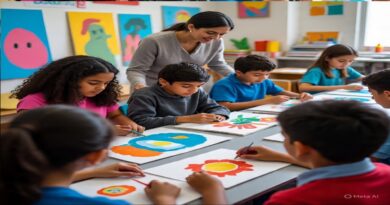Why Art is the Heart of Every Culture
Art and culture have always been at the center of human existence. From the ancient cave paintings of early man to the digital masterpieces of today, both art and culture define who we are and where we come from. They are not just forms of beauty or entertainment they are mirrors reflecting our cultural identity, beliefs, struggles, and dreams. The importance of art goes far beyond aesthetics; it is a language that connects generations, preserves stories, and keeps the soul of humanity alive. Without art, there is no culture; without culture, human creativity loses its direction.
The Importance of Art in Shaping Humanity.
The importance of art in human life cannot be overstated. Art inspires thought, emotion, and imagination. It helps us express what words often cannot.
A painting, a song, or a dance can communicate universal emotions love, pain, joy, or hope beyond linguistic boundaries.
Art educates, awakens, and transforms society by giving people the courage to express themselves freely. It has always been a medium of rebellion and change, challenging injustices and inspiring revolutions. When people engage with art, they engage with their humanity.
Cultural Identity: How Art Defines Who We Are.
Our cultural identity is deeply rooted in our artistic expressions. Every community has unique art forms folk dances, traditional songs, sculptures, or patterns that tell the story of their origin and values. These creative expressions act as identity markers, reminding us of our roots even in a fast-changing modern world.
Whether it’s the intricate calligraphy of Islamic culture, the delicate brush strokes of Chinese art, or the rhythmic beats of African drums each tells a story of belonging. Through art, we preserve the memory of who we are, generation after generation.
Art in Society: The Bridge Between People and Emotions.
The role of art in society is to build connections. Art breaks down barriers between people, helping them see beyond differences. In times of conflict, art becomes a voice of peace; in times of despair, it becomes a symbol of hope. Public art, such as murals and monuments, gives communities a shared sense of pride and identity. Art therapy, too, helps heal emotional wounds and promotes well-being. From museums to social media, art continues to play a vital role in uniting hearts and inspiring minds across the globe.
The Role of Art in Cultural Evolution.
The role of art throughout history has been to document, inspire, and transform. It captures the spirit of every eraits struggles, innovations, and triumphs. During the Renaissance, art became a symbol of human enlightenment; during revolutions, it served as propaganda or protest; and in modern times, it continues to shape public opinion through digital media and film. Artists are often the first to sense change and the first to express it. That’s why every cultural shift is accompanied by a new artistic wave proof that art leads the way for evolution in society.
Art Across Civilizations: A Journey Through Time.
When we study art across civilizations, we see a universal story told in different styles. The Egyptians used art to honor gods and kings, the Greeks celebrated beauty and reason, while Indian and Chinese art reflected spirituality and philosophy. Each civilization used art to record history and express values. Despite differences in medium and method, all shared a common goal to express the unspoken truths of human existence. Even today, ancient art inspires modern creators, proving that creativity is timeless and connects us across centuries.
Cultural Expression: The Language of the Heart.
Cultural expression is the soul of art. Through it, people express emotions, beliefs, and social values. Festivals, dances, paintings, and crafts are not merely traditions they are the emotional vocabulary of a culture. They speak of love, unity, loss, and hope in ways that words cannot. When societies lose their art forms, they lose their ability to express identity and emotion. This is why protecting local art traditions is so vital it ensures that generations to come can still hear the voice of their ancestors through creative expression.
Art Heritage: Preserving the Past for the Future.
Our art heritage is a treasure chest filled with human wisdom and creativity. It holds the legacy of painters, poets, sculptors, and thinkers who shaped civilizations. Preserving art heritage means protecting not only objects but also the stories, values, and skills behind them. Museums, galleries, and cultural foundations play an essential role in keeping these legacies alive. However, it’s also the responsibility of individuals to value and protect their own cultural art forms whether it’s folk music, pottery, or storytelling so that they remain living traditions, not forgotten relics.
Human Creativity: The Force That Drives Progress.
At the heart of every cultural achievement lies human creativity. It is what transforms a blank canvas into a masterpiece, a block of stone into a sculpture, and a melody into an anthem. Creativity is the foundation of innovation in every field art, science, and technology alike. The power to imagine and create something new is what separates humans from all other species. Art gives that creativity direction it channels emotions and experiences into forms that others can see, feel, and be inspired by. Every great artist, from Leonardo da Vinci to Picasso, has shown that creativity is limitless when fueled by passion.
Art and Tradition: The Balance Between Old and New.
Art and tradition together create the rhythm of cultural continuity. Traditions give art its roots, while innovation gives it wings. Every modern art form, no matter how futuristic, is connected to something ancient. Traditional embroidery inspires modern fashion; folk tales shape modern cinema; ancient calligraphy influences digital design. When we respect our traditions while embracing change, art continues to evolve without losing its soul. This balance between old and new ensures that our culture remains alive, dynamic, and meaningful for future generations.
Conclusion: Art as the Eternal Language of Humanity.
In the end, art and culture are not luxuries they are necessities of the human spirit. They teach us empathy, inspire innovation, and preserve identity. The importance of art lies not only in its beauty but in its power to move hearts, heal wounds, and connect souls across boundaries. Whether it’s a child drawing on a wall or a master painting history on canvas, every act of creation is a reflection of the divine spark within humanity. Through art, we remember where we came from, who we are, and what we can become.
Art is not just part of life it is life.



